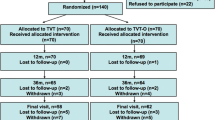Abstract
The aim of this study was to determine whether the position of the tension-free vaginal tape (TVT) has an effect on the resolution of irritative symptoms in women undergoing the TVT operation. Initial audit suggested that more distally placed tapes were more likely to result in the resolution of irritative symptoms. An appropriately powered study was designed to test this theory. Seventy-seven women with urodynamic evidence of detrusor overactivity and urodynamic stress incontinence underwent a transperineal ultrasound scan to ascertain the position of the tape after a TVT. The tape was categorised as proximal, middle or distal urethra. The resolution of irritative symptoms was assessed compared to the TVT position. Forty-five women had distal tapes, 30 had mid-urethral tapes and two had proximal tapes. Women with the TVT placed on the distal urethra were no more likely to experience resolution of their irritative symptoms than women with tapes on the mid-urethra (p > 0.05). Placement of the TVT on any one part of the urethra is not more likely to result in resolution of irritative bladder symptoms.
Similar content being viewed by others
References
Ward K, Hilton P (2002) Prospective multicentre randomised trial of tension-free vaginal tape and colposuspension as primary treatment for stress incontinence. BMJ 325:67–70
Nilsson CG, Kuuva N, Falconer C, Rezapour M, Ulmsten U (2001) Long-term results of the TVT procedure for surgical treatment of female stress urinary incontinence. Int Urogynecol J 12(Suppl 2):S5–S8
Karram MM, Bhatia NN (1989) Management of coexistent stress and urge urinary incontinence. Obstet Gynecol 73(1):4–7
Khullar V (2001) Ultrasonography. In: Cardozo L, Staskin D (eds) Textbook of female urology and urogynecology. Martin Dunitz, London, pp 299–312
Dietz HP (2004) Ultrasound imaging of the pelvic floor: two-dimensional aspects. Ultrasound Obstet Gynecol 23:80–92
Dietz HP, Eldridge A, Grace M, Clarke B (2003) Test–retest reliability of ultrasound assessment of bladder neck mobility. Int Urogynecol J 14(S1):S57–S58
Dietz HP, Eldridge A, Grace M, Clarke B (2004) Pelvic organ descent in young nulliparous women. Am J Obstet Gynecol 191:95–99
Duckett JR, Tamilselvi A (2006) Effect of tension-free vaginal tape in women with a urodynamic diagnosis of idiopathic detrusor overactivity and stress incontinence. BJOG 113:30–33
Ulmsten U, Henriksson L, Johnson P, Varhos G (1996) An ambulatory surgical procedure under local anaesthesia for treatment of female urinary incontinence. Int Urogynecol J 7:81–86
Kelleher CJ, Cardozo LD, Khullar V, Salvatore S (1997) A new questionnaire to assess the quality of life of urinary incontinent women. Br J Obstet Gynaecol 104:1374–1379
Abrams P, Cardozo L, Fall et al (2002) The Standardisation of terminology of lower urinary tract function: report from the standardisation sub-committee of the International Continence Society. Neurourol Urodyn 21:167–178
Lo T, Wang AC, Horng S, Liang C, Soong Y (2001) Ultrasonographic and urodynamic evaluation after tension free vaginal tape procedure (TVT). Acta Obstet Gynecol Scand 80:65–70
Dietz HP, Mouritsen L, Ellis G, Wilson PD (2004) How important is TVT location? Acta Obstet Gynecol Scand 83:904–908
Sarlos D, Kuronen M, Schaer GN (2003) How does tension-free vaginal tape correct stress incontinence? Investigation by perineal ultrasound. Int Urogynecol J 14:395–398
Dietz HP, Wilson PD (2004) The ‘iris effect’: how two-dimensional and three-dimensional ultrasound can help us understand anti-incontinence procedures. Ultrasound Obstet Gynecol 23:267–271
Kaum HJ, Wolff F (2002) TVT: on midurethral tape positioning and its influence on continence. Int Urogynecol J 13:110–115
Dietz HP, Foote AJ, Mak HLJ, Wilson PD (2004) TVT and Sparc suburethral slings: a case–control series. Int Urogynecol J 15:129–131
Jung SY, Fraser MO, Ozawa H, Yokoyama O, Yoshiyama M et al (1999) Urethral afferent nerve activity affects micturation reflex, implication for the relationship between stress incontinence and detrusor instability. J Urol 162(1):204–212
Hindmarsh JR, Gosling PT, Deane AM (1983) Bladder instability. Is the primary defect in the urethra? Br J Urol 55:648–651
Dietz HP, Barry C, Lim Y, Rane A (2006) TVT vs Monarc: a comparative study. Int Urogynecol J 17:566–569
Author information
Authors and Affiliations
Corresponding author
Rights and permissions
About this article
Cite this article
Duckett, J., Aggarwal, I., Patil, A. et al. Effect of tension-free vaginal tape position on the resolution of irritative bladder symptoms in women with mixed incontinence. Int Urogynecol J 19, 237–239 (2008). https://doi.org/10.1007/s00192-007-0409-6
Received:
Accepted:
Published:
Issue Date:
DOI: https://doi.org/10.1007/s00192-007-0409-6




